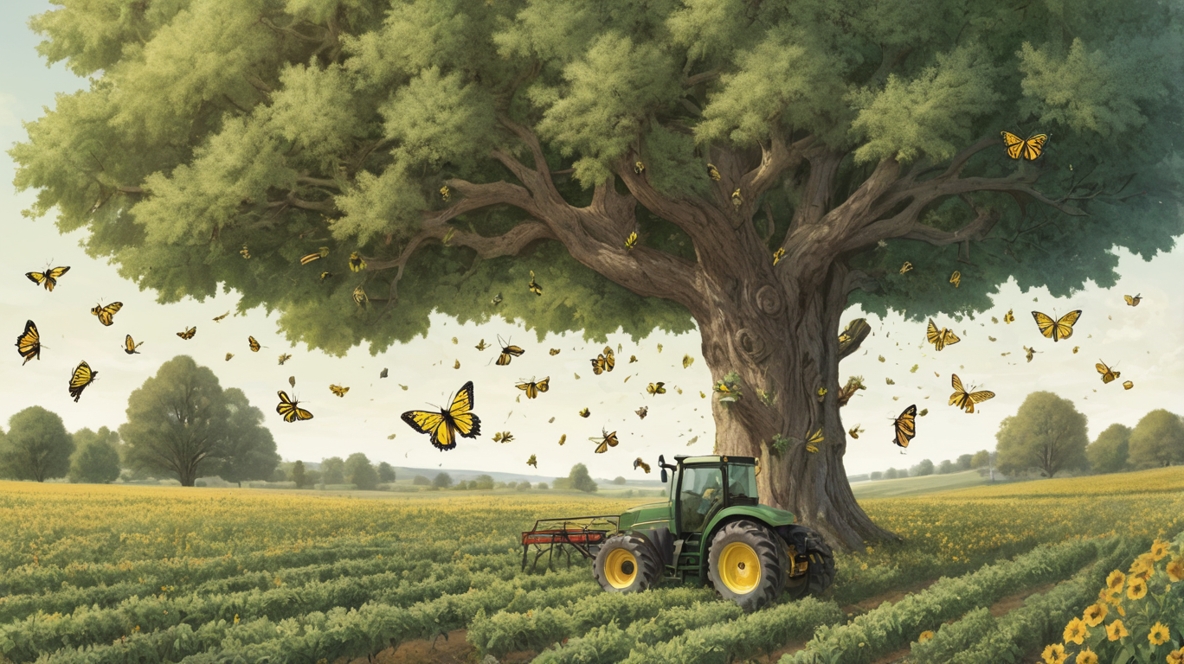A farm without buzzing bees, fluttering butterflies, or tiny ground beetles would be an eerie sight. Nature thrives on these small but mighty workers, yet their numbers have taken a hit. The way we grow food plays a big role in their survival, and tree-based farming has proven to be a lifeline. By weaving trees into farmland, this method creates a home where pollinators and beneficial insects can not only survive but flourish.
Why Pollinators and Beneficial Insects Need Tree-Based Farms
Pollinators don’t just help flowers bloom—they support the very foundation of food production. Bees, butterflies, and even beetles carry pollen from plant to plant, ensuring fruits, nuts, and vegetables grow. Beneficial insects, like ladybugs and predatory wasps, keep pest populations in check, reducing the need for chemical sprays.
But open fields with a single crop type provide little shelter or food for these vital species. That’s where tree-based farming changes the game. By integrating trees with crops or livestock, this approach builds a diverse environment that mimics natural ecosystems. It gives pollinators and helpful insects everything they need: food, nesting sites, and protection from harsh weather.
How Trees Provide Pollinators with a Steady Food Supply
Extended Bloom Periods
Crops often bloom for a short time, creating a feast-and-famine cycle for pollinators. Trees help fill the gaps. Many flowering trees bloom before or after crops, ensuring food is available throughout the season.
Diverse Nectar Sources
Different trees attract different pollinators. Some provide nectar for bees, while others draw butterflies or beetles. This variety ensures a wide range of pollinators stay active in the area.
Pollen with High Nutritional Value
Not all pollen is created equal. Trees like willows and maples produce protein-rich pollen that strengthens bee colonies, helping them survive through tough seasons.
Shelter and Nesting Spaces: Essential for Survival
Safe Havens from Extreme Weather
Open fields expose insects to scorching sun, heavy rain, and strong winds. Trees act as windbreaks and provide shade, helping pollinators and beneficial insects stay protected.
Natural Nesting Sites
Many wild bees nest in hollow tree trunks, cracks in bark, or rotting wood. When farmland includes trees, it offers a natural alternative to artificial bee hotels.
Winter Survival Spots
Unlike honeybees, many native bees don’t live in hives. They hibernate in soil, dead wood, or under leaf litter. Tree-based farms create spaces for these species to make it through winter.
How Trees Attract and Support Beneficial Insects
Not all bugs are bad. Many play a direct role in controlling crop pests, and trees create the perfect habitat for these hardworking allies.
Encouraging Predatory Insects
- Ladybugs feast on aphids, which damage crops.
- Lacewings eat soft-bodied pests like whiteflies.
- Parasitic wasps lay eggs inside pest insects, keeping their numbers down naturally.
Hosting Spiders and Other Natural Pest Controllers
Spiders may not be the first thing that comes to mind when thinking about helpful creatures, but they are one of the best natural pest controllers. Tree branches, bark, and leaves give them the ideal spots to spin their webs and hunt crop-damaging insects.
A Home for Ground Beetles and Other Soil Guardians
Many beneficial insects live in the soil, feeding on pests that attack plant roots. Trees create stable soil conditions, keeping these underground defenders active year-round.
The Role of Agroforestry in Boosting Biodiversity
More Than Just a Farm—A Thriving Ecosystem
A typical farm grows a single crop across vast areas, which limits the variety of species that can survive there. Tree-based farming, however, creates layers of vegetation, much like a forest. This layered structure allows different species to find their niche, increasing overall biodiversity.
Breaking Pest Cycles
Monoculture farming—where only one crop is grown—makes it easy for pests to spread. Trees mixed with crops break up these large, open spaces, making it harder for pests to move freely and cause widespread damage.
Encouraging Healthy Soil Life
Trees improve soil by dropping leaves that decompose and feed underground organisms. This supports insects like decomposers, which, in turn, help keep the entire food web balanced.
Which Trees Work Best for Pollinators and Beneficial Insects?
The right trees make all the difference. Some provide nectar, others shelter, and a few do both.
Best Trees for Pollinators
- Fruit Trees – Apple, pear, cherry, and plum trees attract bees with their fragrant blossoms.
- Native Flowering Trees – Willow, maple, and black locust trees offer nectar early in the season when few other plants are blooming.
- Nut Trees – While their main role is producing nuts, trees like almonds and hazelnuts also provide valuable pollen for bees.
Best Trees for Beneficial Insects
- Oak Trees – Support dozens of insect species, providing food for predatory bugs.
- Mulberry Trees – Attract ladybugs and lacewings, helping with natural pest control.
- Hawthorn Trees – A favorite of pollinators and predatory wasps.
Practical Steps for Farmers and Growers
Planting the Right Mix of Trees
Choosing a mix of flowering, fruit-bearing, and nut trees ensures a steady supply of nectar and pollen. The more variety, the better.
Spacing and Placement Matter
- Plant trees near crops that rely on pollination for higher yields.
- Use tree lines to create windbreaks and nesting spots.
- Leave patches of wild vegetation nearby to give beneficial insects even more options for shelter and food.
Let Nature Take Its Course
Resist the urge to clear every fallen leaf or prune every branch. Deadwood and undisturbed soil are essential nesting sites for many species.
Minimize Pesticide Use
Even organic sprays can harm beneficial insects. Spot treatment, instead of blanket applications, helps reduce unintended harm.
Final Thoughts
Tree-based farming isn’t just a method—it’s a way to rebuild natural balance. When trees stand alongside crops, pollinators and beneficial insects gain food, shelter, and protection, leading to healthier farms and stronger ecosystems. The benefits ripple outward, from better soil to improved yields, creating a system that supports both agriculture and nature. Farmers, growers, and landowners who embrace this approach don’t just grow food; they cultivate life itself.
